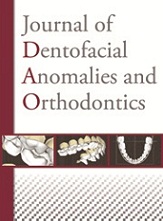Article contents
Upper canines and incisors: how a better knowledge of their morphology can help us to optimise their function
Published online by Cambridge University Press: 21 September 2010
Abstract
Biometric study of contemporary human maxillary incisors and canine coronal morphology
The orthodontic alignment or prosthetic rehabilitation of the upper anterior sector is based on available biometric data.
The aim of this study is to measure the angle formed between the functional lingual surface of the canine and central incisor and the axial-orbital plane.
Materials and methods
This retrospective study is based on an analysis of documents of young dental students.
The measurements were made on 49 silicone models of healthy, natural, functional teeth, in class I occlusion for the maxillary anterior group.
Results
The values of slope angulations of the lingual surfaces relative to the axial-orbital plane clearly decrease by 10° from the central incisor (57°) to the canine (47°).
If there is stability in buccal morphology, there is variability in anterior lingual morphology, particularly of the canine.
These variations in an essential zone on the functional level are marked enough to warrant being taken into account in clinical practice.
- Type
- Research Article
- Information
- Journal of Dentofacial Anomalies and Orthodontics , Volume 13 , Issue 1: The canine , March 2010 , pp. 40 - 54
- Copyright
- © RODF / EDP Sciences, 2010
- 3
- Cited by


